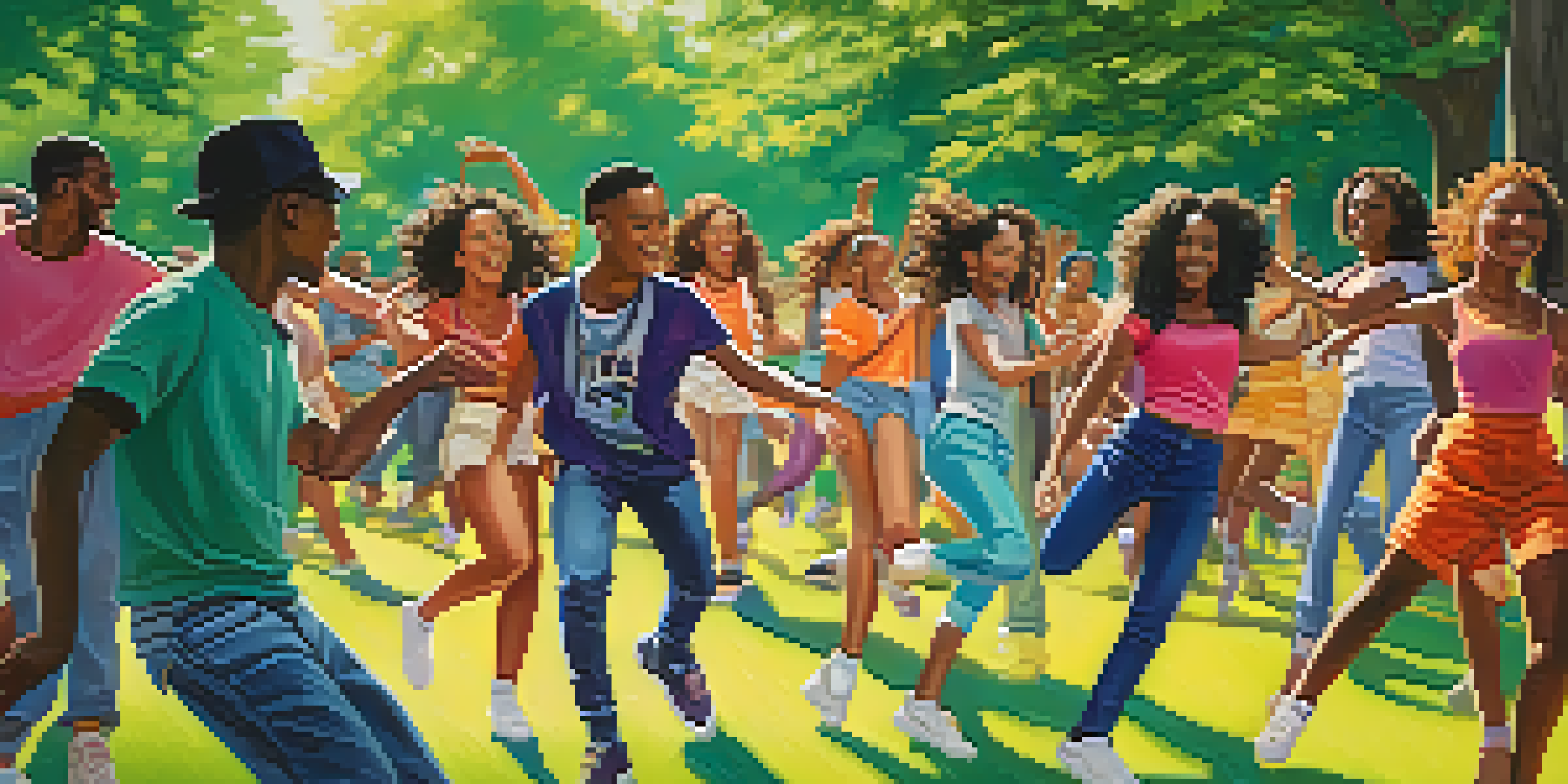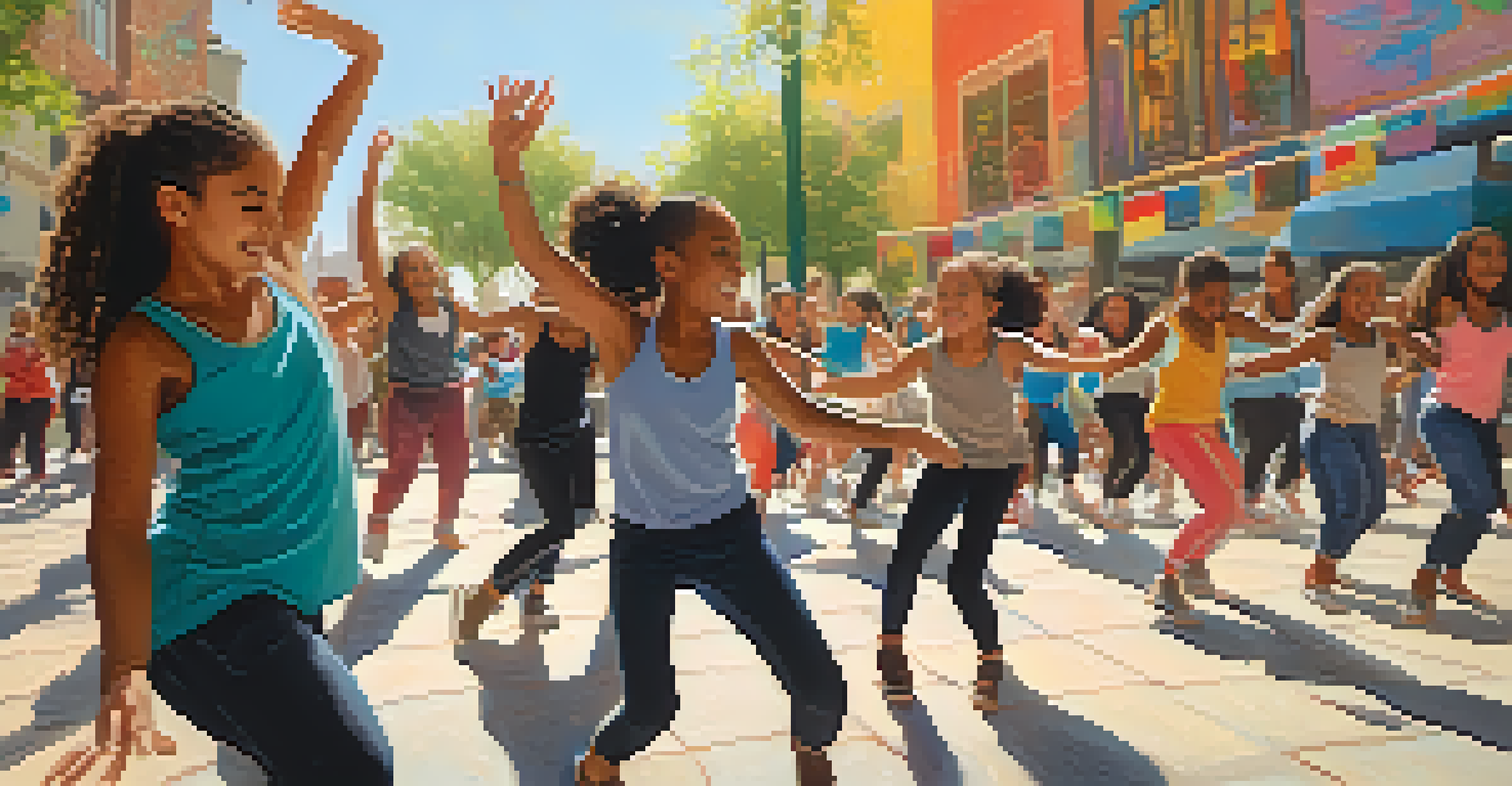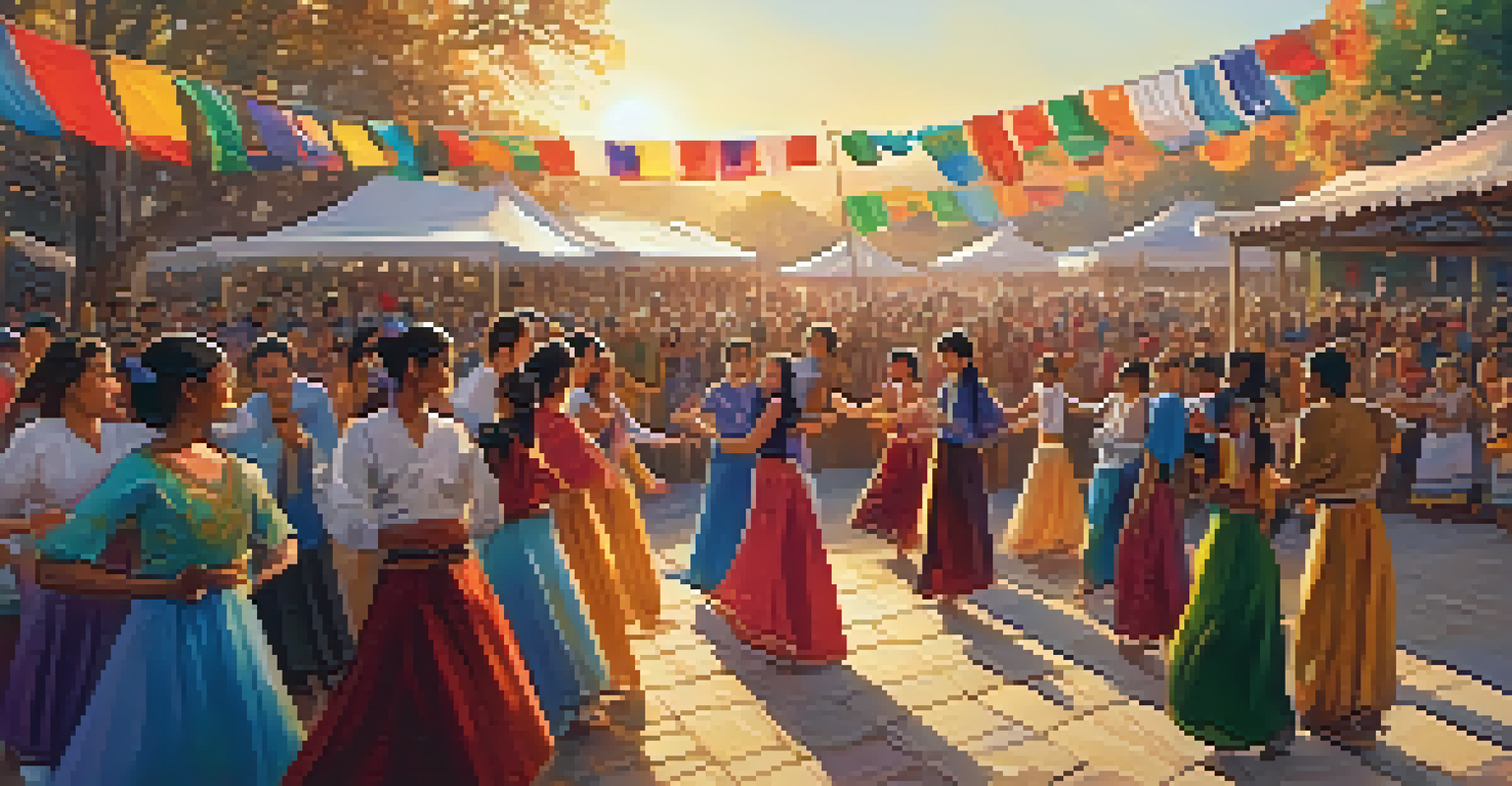Engaging Youth through Dance in Public Spaces

The Power of Dance to Unite Communities
Dance has a unique ability to bring people together, transcending language and cultural barriers. When youth engage in dance in public spaces, they create a shared experience that fosters connection and understanding. This communal activity can turn a crowded park into a vibrant hub of creativity and joy.
Dance is the hidden language of the soul.
Imagine a group of teenagers gathering in a local plaza, their laughter echoing as they break into an impromptu dance. This spontaneous moment not only entertains but also encourages onlookers to join in, creating a ripple effect of participation and community spirit. Dance becomes a bridge, inviting everyone to share their stories and cultures.
Ultimately, the power of dance lies in its ability to cultivate community bonds, encourage inclusivity, and strengthen social ties among youth. When young people come together to dance, they are not just moving their bodies; they are weaving a richer social fabric that benefits everyone.
Public Spaces: The Ideal Canvas for Expression
Public spaces, like parks and squares, serve as perfect canvases for youth engagement through dance. These areas are easily accessible and often frequented by a diverse crowd, making them ideal for spontaneous performances and organized events alike. The open environment encourages creativity and self-expression, allowing young dancers to showcase their talents.

Consider a bustling city park where a flash mob takes place. The vibrant colors, dynamic movements, and infectious energy draw in passersby, transforming an ordinary day into an extraordinary one. Such events not only highlight the dancers’ skills but also invite community members to witness and appreciate their local talent.
Dance Unites Diverse Communities
Dance transcends cultural barriers, fostering connection and shared experiences among youth in public spaces.
By utilizing public spaces for dance, youth can reclaim these areas as places of joy and creativity. This not only enhances the atmosphere of the environment but also encourages more people to explore and engage with their community.
Building Confidence and Skills through Dance
Engaging in dance helps youth build confidence and develop essential skills. When they perform in public, they learn to navigate the challenges of stage fright and self-doubt, emerging stronger and more self-assured. This newfound confidence often spills over into other aspects of their lives, from academics to social interactions.
The dance is a poem of which each movement is a word.
Additionally, dance promotes teamwork and collaboration. When young dancers work together, they learn to communicate effectively, listen to one another, and support their peers. This collaborative spirit not only enhances their dance skills but also fosters lasting friendships and a sense of belonging.
In this way, dance becomes more than just an art form; it’s a powerful tool for personal development. As youth engage with one another through dance, they cultivate resilience, adaptability, and a strong sense of community responsibility.
Fostering Cultural Awareness and Appreciation
Dance is a beautiful expression of culture, and involving youth in dance can enhance cultural awareness and appreciation. When young people participate in diverse dance styles, they gain insights into different traditions and histories, promoting inclusivity and respect for one another’s backgrounds. This cultural exchange enriches their understanding of the world.
For instance, a community dance festival showcasing various cultural dances not only entertains but also educates attendees. As youth learn traditional dances from different cultures, they develop a deeper appreciation for the uniqueness of each expression. This awareness fosters empathy and a sense of global citizenship.
Boosting Confidence Through Dance
Participating in dance helps youth build self-confidence and essential teamwork skills, enriching their overall development.
Ultimately, dance serves as a bridge connecting youth to their heritage while also introducing them to new cultures. This celebration of diversity helps build a more inclusive community where everyone feels valued and respected.
Encouraging Healthy Lifestyles through Movement
Incorporating dance into public spaces encourages youth to adopt healthier lifestyles. As they participate in physical activity, they not only enjoy the immediate benefits of movement but also establish habits that contribute to their overall well-being. Dance is a fun way to stay active and combat sedentary behaviors common in today’s digital age.
Moreover, dance can be an excellent outlet for stress relief. When youth express themselves through movement, they release pent-up energy and emotions, which can significantly improve their mental health. This physical expression becomes a coping mechanism, allowing them to navigate the challenges of adolescence more effectively.
By promoting dance as a form of exercise, communities can inspire young people to prioritize their health in enjoyable ways. This shift not only fosters better physical health but also encourages a positive mindset, leading to happier, more engaged individuals.
Creating Opportunities for Local Artists
Engaging youth through dance in public spaces can also create valuable opportunities for local artists. By organizing dance workshops and performances, communities can provide a platform for emerging choreographers and dancers to showcase their talents. This not only enriches the local arts scene but also inspires youth to pursue their passion for dance.
Imagine a local dancer leading a workshop in a community park, teaching young participants various dance styles. This interaction not only empowers the youth but also allows the artist to share their knowledge and love for dance with the next generation. Such initiatives can cultivate a rich community of artists and audiences.
Cultural Awareness via Dance
Engaging in various dance styles enhances youth's cultural appreciation, promoting inclusivity and respect for diverse backgrounds.
Moreover, supporting local artists through youth engagement initiatives strengthens community ties. By investing in the arts, communities foster creativity and innovation, creating a vibrant cultural landscape that benefits everyone.
The Future of Youth Engagement through Dance
As communities continue to explore ways to engage youth, dance in public spaces presents a promising avenue. The potential for creativity, connection, and cultural exchange is limitless, paving the way for innovative initiatives and collaborations. By embracing this art form, communities can create enriching experiences for youth and foster a sense of belonging.
Looking ahead, integrating technology with dance could further enhance engagement. For instance, virtual dance challenges and social media platforms can amplify participation and connect youth with others far beyond their local area. This blend of tradition and innovation can keep the spirit of dance alive and thriving.

Ultimately, the future of youth engagement through dance lies in collaboration, creativity, and community support. By nurturing these values, we can ensure that dance remains a vibrant and transformative force in the lives of young people.